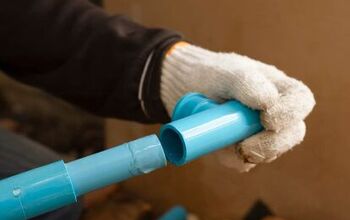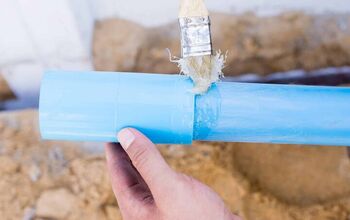How To Connect A PVC Pipe Without Glue

PVC pipes are often called adult erector sets. This is because they are so easy to put together and make whatever you want. Durable and capable of carrying liquids and gasses they are an amazing pipe.
The only problem is if you want to take them apart. If you use PVC glue it will waterproof your pipes, but you will have a hard time ever taking them apart again
If you want to connect PVC pipe without glue use a push to connect fitting sold at most hardware stores. Otherwise use some of this duct tape and separate 2 small strips. Place one on either side of the pipe that will insert into the fitting to make the pipe fit extremely snug.
In this article, we will tell you how to connect PVC pipes without using glue. That way, you won’t need to mess with the sticky side of the project. Keep on reading for more tips and tricks!
Do You Need to Hire a Plumber?
Get free, zero-commitment quotes from pro contractors near you.

Benefits Of PVC Piping
- Durable: PVC piping is resistant to abrasion, weathering, chemical rotting, shock, and corrosion.
- Ease of Setup: You can easily shape, weld, and cut PVC piping. Also, you can easily join it together to create the design you want.
- Last Longer: PVC pipes have an estimated life of approximately 100 years.
- Safe: PVC has been found to be safe for its typical uses. Also, its environmental impact is comparable to similar products.
- Fire Retardant: PVC piping is fire resistant which is a good safety feature in homes.
- Watertight: These pipes tight seals which are virtually leak free.
- Low Cost: PVC piping costs less than most other piping options.
PVC Pipe Uses
PVC piping works for many applications. Notably, its most common use consists of transporting fluids, especially water or sewage. Furthermore, PVC piping comes in a large number of sizes capable of transporting rainwater, drinking water, and sewage.
Additionally, piping has uses beyond the usual household plumbing. Since this piping is so durable and versatile, it is quite useful in homes.
You can use it to divert water away from your basement or driveway. Also, you can use it to build simple structures. There are plenty of projects that PVC pipes are perfect for, you just need to be creative to find them!
Options Without Glue
Glue offers a permanent and easy way to connect PVC pipes but there are other options. These include:
- Pushing hard: PVC pipe fits very snugly if you do not intend it to carry water or gas it will typically remain together if not exposed to other forces.
- Taping: By using some duct tape you can slightly increase the diameter of your pipe. As with the previous option, PVC pipe is designed to fit very snugly by using some tape to make it slightly more snug and provide some friction it can stand up to some pretty strong beating.
- Old bicycle inner tube: By cutting off a small piece of bicycle inner tube and fitting it around the end of one pipe so it extends slightly over the edge of the lip you can make both an increased diameter and a gasket that will even enable you to move liquid inside the pipe
- Compression fittings: These fittings are also called push to connect fittings and are sold just for this purpose. They have an o-ring to waterproof and a steel ring that crimps to grip onto the PVC pipe inserted. With a special tool sold by the brands that sell these fittings, you can even remove and reuse them.
- Buy threaded PVC: Most PVC pipe isn’t pre-threaded but it is not that hard to get. If you haven’t purchased the supplies for your PVC project and you don’t want to use glue consider getting pre-threaded pipes.
- Use a pipe threader: It can cost a bit to purchase a PVC pipe threading tool. However, this will allow you to add threads to existing PVC pipes and use threaded fittings to join them.
- Flexible couplings: These are rubber rings that can be slipped over two PVC pipes. They typically come with 2 hose clamps you will tighten to bind the pipes together. This is particularly useful in plumping.
How To Use These Options?
Compression fittings flexible couplings and pre-threaded pipes do not need further explanation, but the other options all do. We will tell you how to use each of these options now.
Taping
First of all if you do not need the connection to last long at all just connect the pipes and wrap around the outside. However, for connections that last more than a day you will need to be more creative. This method will probably leak, but it will hold for a longer time. follow these steps:
- Buy some tape. Get some durable duct tape, Gorilla tape works well. Cut off 2 small pieces about a 1/3 of an inch long.
- Apply the tape. Place one piece lengthwise around on the inside of your pipe over the lip to the outside.
- Repeat step 3 on the other side of the same end of the pipe.
- Insert the pipe to your fitting. Press the pipe into your fitting it will be difficult but press it in as firm as you can manage.
- Try pulling the pipe out. You have now slightly increased the diameter of your pipe. It should fit very snugly and be extremely difficult to pull out.
Old Bicycle Inner Tube
The advantage of this method is its cheapness, ability to hold liquid, and many people can do this without a trip to the hardware store. If you want to try a trip to a bicycle shop, they will often give you busted old inner tubes for free. Just follow these steps to get started:
- Cut a chunk of the inner tube off. The length depends on how deep the fitting goes make sure it is a bit longer than the depth of the fitting’s connector. Generally, longer is better than short. A few inches will probably do.
- Slip the chunk of tubing over the end of your PVC pipe it should be snug. Make sure it goes hangs slightly over the lip still.
- Insert your pipe into the fitting. It will be extremely snug. Push Hard.
- Form the tube. Now bend the exposed part of your tube back over the end of the fitting.
- Check the connection. This connection is among the best you can get with makeshift components it’s pretty firm and the rubber tube serves as a gasket.
How To Thread PVC
PVC threaders come in multiple styles but the most common employs a small metal disc with sharp internal threads called a die. The threader is placed in a handle and used to physically cut the threads. Threading PVC is not that hard you will just need a PVC threading tool, a rag, and a vise clamp. Follow these steps:
- Clamp the pipe. Wrap the rag around the middle of the PVC pipe and clamp in the vise.
- Set the pipe in. Place the threading tool on the edge of the pipe and turn clockwise while pushing it onto the pipe until the tool’s edge strikes the end of the pipe.
- Turn clockwise to remove. Remove the pipe from the clamp and use the rag to wipe the new threads clean.
Undoing PVC Glue And Fittings
If you have some PVC that has been glued then you can break the bond by heating the plastic. You will want the temperature to be between 250 to 350 degrees Fahrenheit to ensure that you break the bond. The glue and the plastic will soften so that you can get the pipe out of the fitting.
This also works to break the seal that a fitting created over the PVC pipe. So if you don’t have glue, but you cannot get the fitting unstuck, you can always soften the plastic pieces to remove them. Just make sure you don’t heat it up too much otherwise you’ll break the fitting and have to buy a new one.
Related Questions
Can PVC piping be used for a drainpipe?
PVC pipe can be used for a drainpipe because it is sturdy and long-lasting. Generally, you should use schedule 40 for drainpipes because it has a larger inside diameter.
Will a PVC pipe leak without glue?
PVC pipes have special fittings that help ensure there are no leaks, however not every application will require you to provide a permanent seal such as this type. The cement is not like normal glue, but yes, you can connect the PVC pipes without glue, and put on a special fitting to ensure there are no leaks.
What can I use instead of PVC glue?
If you don’t want to use PVC glue, you can always try contact cement, super glue, hot glue or special fittings. All of these work just as well as PVC glue works.
Do You Need to Hire a Plumber?
Get free, zero-commitment quotes from pro contractors near you.

Summing It All Up
Sometimes people opt out of using PVC glue, and that’s understandable. Maybe they want a less permanent solution, or they don’t want to deal with the mess. Instead of glue, you can use special fittings to hold your PVC pipes in place to do the job that you want them to. The fittings will prevent leakages.

I am a writer who enjoys working on home improvement projects. My husband was in the navy, so we moved frequently. This gave me many opportunities to fix up new places. In my spare time, I enjoy reading mysteries and hiking.
More by Lisa Borga



























